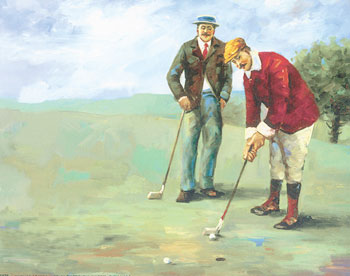The 2017 Colorado Golf Association championship schedule kicks off with two team events; our CGA Senior Four-Ball Championship is directly followed by our CGA Four-Ball Championship. For any Seniors playing in both events, you will be playing six days of Four-Ball stroke play in the span of seven days.
While Four-Ball stroke play is very similar to an individual stroke play event, there are some key points that competitors need to be aware of to properly play and strategize for the championship. Knowing the basic concepts of Rule 31 can help a side to better strategize how to play throughout the championship.
Four-Ball stroke play is a format in which two competitors play as partners, and each partner will play his own ball. The lower score of the partners is the score for the hole. These two players are now considered what is called a “side”.
When playing Four-Ball stroke play, both partners do not need to hole out. For instance, if your partner has hit two balls out of bounds and you are on the putting green lining up a birdie putt, he can probably go ahead and pick up his ball. This can be helpful to keep in mind regarding pace of play if your group has fallen behind and needs to make up some time. However, if your partner wishes to keep playing out the hole, there is no penalty.
The Score Card
One of the most important things to remember during Four-Ball stroke play is that when a side returns their score card the scores MUST be individually identifiable (see pictures below). The Committee must be able to tell which partner recorded a score on a specific hole. However, when a side returns its scorecard, only one partner needs to sign the score card as its marker of competitor’s signature.
One of the most important things to remember during Four-Ball stroke play is that when a side returns their score card the scores MUST be individually identifiable (see pictures below). The Committee must be able to tell which partner recorded a score on a specific hole. However, when a side returns its scorecard, only one partner needs to sign the score card as its marker of competitor’s signature.
Order of Play
One important rule to know about Four-Ball stroke play is Rule 31-4. When deciding who is to play first from the teeing ground, the side that has the honor may decide which partner tees off first. However, during play of a hole, the side that is farthest away from the hole will play first. The same concept applies as it did on the teeing ground.
For instance, let’s say that Player A and Player B are playing with Player C and Player D. After all competitors play their tee shots, Player A is farthest away from the hole. Player B (same side) may play first because the side of Player A and Player B may choose who plays first, even if Player B is much closer to the hole than any other player in that group.
Wrong Ball
If a partner makes a stroke at a wrong ball, Rule 15-3b applies and he is penalized two strokes and must correct his mistake by playing the correct ball or by proceeding under the Rules. This also applies if your partner accidentally plays your ball. If your partner accidentally plays your ball, you must place a ball on the spot from where your partner played your ball. You would not be penalized, but your partner is now penalized two strokes and must go play his ball.
Effect of penalties Affecting your Partner
Be cautious when assessing a situation that may affect your partners play. If you breach a Rule that simultaneously assists your partner, your partner will also incur the applicable penalty. A good example is if you were to remove a loose impediment from a bunker that interfered with your line of play AND this action assisted your partner, he would also incur the applicable penalty. However, if this breach did not affect your partner, you would still receive the applicable penalty, but your partner would not be penalized.
If you have any other questions, please feel free to follow up by calling the CGA offices or give Rule 31 a read before you tee off.


